Research
Galactic-scale outflows are quite common among vigorously star-forming galaxies, and are expected to play a key role in the process of galaxy evolution. The observed global decline in star formation between z~1 and today, as well as the increased number density of red sequence galaxies, are both likely driven by the expulsion of gas from galactic star-forming regions. My research has focused on characterizing the properties of outflows in galaxies at z < 1.5 using a few different techniques.
- Galaxies Probing Galaxies
- Cool Outflows in z~1 Galaxies
- White Dwarfs in Open Clusters
In addition, I am a proud member of IMPS -- the Inter[stellar and galactic] Medium Program of Studies at UC Santa Cruz
|
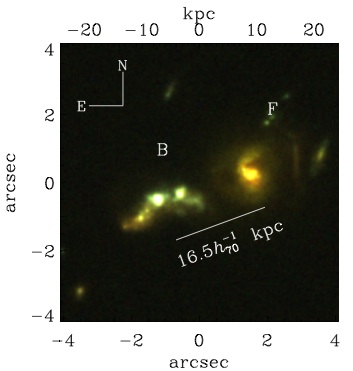
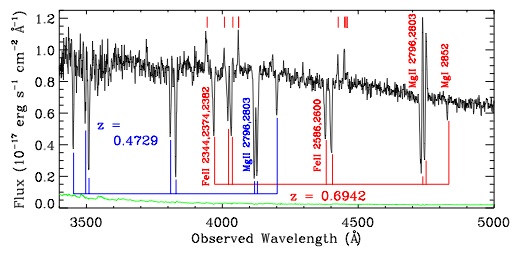
Several lines of evidence link galactic outflows to the cool (T ~ 10^4 K) gas seen in absorption in galaxy halos; however, the true physical origins of halo absorption line systems observed out to ~100 kpc from their host galaxies are still not well understood. QSOs are typically used as background light sources to probe the absorption kinematics of these systems. However, bright, high surface brightness galaxies can also serve as background probes of foreground galaxy halos. The two galaxies shown in the above Hubble Space Telescope image are close on the sky, but are well separated in redshift. The blue galaxy marked "B" is at z=0.69, while the redder galaxy marked "F" is at z=0.47. We took a spectrum of the galaxy in the background ("B") with the Low Resolution Imaging Spectrograph on Keck, shown on the right. Absorption lines intrinsic to the background galaxy are marked in red, and are blueshifted with respect to systemic velocity by ~ -300 km/s, indicating an outflow of cool gas. Strong MgII, MgI, and FeII absorption at the foreground galaxy redshift is marked in blue, and reveals cool, metal-enriched clouds in the halo of the foreground galaxy. To read more about this system, please see Rubin et al. 2009a.
|
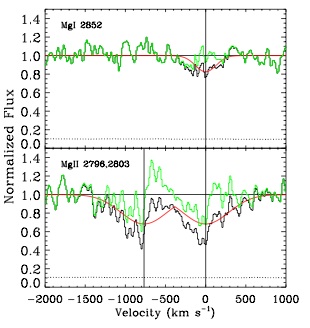 In distant galaxies, outflows are traditionally studied using spectroscopy of low-ionization absorption lines. We have coadded ~400 spectra from the Team Keck Treasury Redshift Survey of galaxies at 0.7 < z < 1.5 and analyzed the MgII 2796, 2803 absorption line profiles to characterize outflow properties. At the right, we show sections of the coadded spectrum near the MgII and MgI 2852 transitions in black. The solid vertical lines show the systemic velocity of the transitions. The Mg absorption profiles are clearly asymmetric, and exhibit significantly more absorption to the blue of systemic velocity, indicative of outflowing gas. The red profiles show our model for absorption due to stellar atmospheres and the interstellar medium at the systemic velocity, and the green profile shows absorption due purely to outflowing gas. By subdividing the galaxy sample, we find that the outflow absorption strengths increase with both the average star formation rate and stellar mass at z~1. Through comparison with the work of Weiner et al. 2009, we find that strong outflows persist in high stellar mass galaxies (log M*/Msun > 10.5) as they evolve from z~1.4 to ~1. For more details, please see Rubin et al. 2009b. In distant galaxies, outflows are traditionally studied using spectroscopy of low-ionization absorption lines. We have coadded ~400 spectra from the Team Keck Treasury Redshift Survey of galaxies at 0.7 < z < 1.5 and analyzed the MgII 2796, 2803 absorption line profiles to characterize outflow properties. At the right, we show sections of the coadded spectrum near the MgII and MgI 2852 transitions in black. The solid vertical lines show the systemic velocity of the transitions. The Mg absorption profiles are clearly asymmetric, and exhibit significantly more absorption to the blue of systemic velocity, indicative of outflowing gas. The red profiles show our model for absorption due to stellar atmospheres and the interstellar medium at the systemic velocity, and the green profile shows absorption due purely to outflowing gas. By subdividing the galaxy sample, we find that the outflow absorption strengths increase with both the average star formation rate and stellar mass at z~1. Through comparison with the work of Weiner et al. 2009, we find that strong outflows persist in high stellar mass galaxies (log M*/Msun > 10.5) as they evolve from z~1.4 to ~1. For more details, please see Rubin et al. 2009b.
|
 During my first two years in graduate school, I worked with Mike Bolte and Kurtis Williams on a photometric and spectroscopic study of white dwarfs in the open cluster M34. We use our results to further constrain the white dwarf initial-final mass relation. For details, please see Rubin et al. 2008. During my first two years in graduate school, I worked with Mike Bolte and Kurtis Williams on a photometric and spectroscopic study of white dwarfs in the open cluster M34. We use our results to further constrain the white dwarf initial-final mass relation. For details, please see Rubin et al. 2008.
|
|
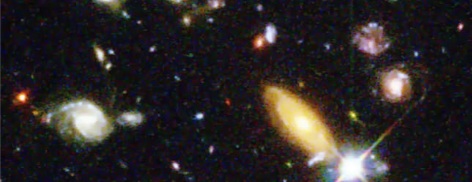
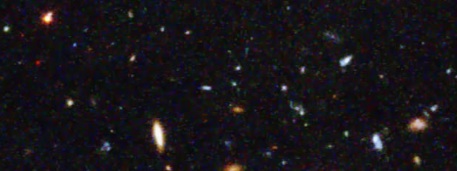


 In distant galaxies, outflows are traditionally studied using spectroscopy of low-ionization absorption lines. We have coadded ~400 spectra from the
In distant galaxies, outflows are traditionally studied using spectroscopy of low-ionization absorption lines. We have coadded ~400 spectra from the  During my first two years in graduate school, I worked with Mike Bolte and Kurtis Williams on a photometric and spectroscopic study of white dwarfs in the open cluster M34. We use our results to further constrain the white dwarf initial-final mass relation. For details, please see
During my first two years in graduate school, I worked with Mike Bolte and Kurtis Williams on a photometric and spectroscopic study of white dwarfs in the open cluster M34. We use our results to further constrain the white dwarf initial-final mass relation. For details, please see